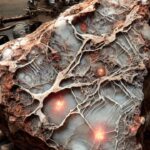NASA Wildfire Digital Twin, AI wildfire prediction, wildfire smoke forecasting, wildfire management technology, real-time wildfire simulation, AI in disaster management, NASA fire forecasting, wildfire smoke dispersion, advanced fire prediction tools, NASA AI tools
Discover how NASA’s Wildfire Digital Twin is transforming wildfire management. This AI-powered system provides real-time fire and smoke forecasting, enhancing prediction accuracy, resource allocation, and public safety. Learn about its innovative technology, real-world applications, and future potential.

Wildfires have become a significant threat to ecosystems, human lives, and property worldwide. In recent years, the frequency and intensity of these fires have increased, partly due to climate change. As a result, there is an urgent need for advanced technologies to predict, monitor, and manage wildfires more effectively. NASA, known for its cutting-edge space research and technology, has developed a groundbreaking tool called the Wildfire Digital Twin. This innovative AI-powered system is transforming how we forecast fire and smoke behavior, offering new hope in mitigating the devastating effects of wildfires.
What is the Wildfire Digital Twin?
The Wildfire Digital Twin is an advanced AI system developed by NASA to create real-time simulations of wildfires. It leverages data from various sources, including satellites, drones, and ground-based sensors, to provide accurate and timely information about fire behavior and smoke dispersion. By integrating this data into sophisticated models, the Wildfire Digital Twin can predict the spread of fires and the movement of smoke, allowing for more effective firefighting strategies and public safety measures.
How Does the Wildfire Digital Twin Work?
The core of the Wildfire Digital Twin’s functionality lies in its ability to assimilate vast amounts of data and process it through machine learning algorithms. Here’s a breakdown of its working mechanism:
- Data Collection: The system collects data from multiple sources. Satellites provide high-resolution images of affected areas, while drones and ground-based sensors offer detailed information on local conditions such as temperature, humidity, wind speed, and fuel moisture content.
- Data Integration: Once the data is collected, it is integrated into a unified model. This model considers various factors influencing fire behavior, including topography, vegetation type, and weather conditions.
- Simulation and Prediction: Using advanced AI algorithms, the system simulates fire behavior and predicts its future spread. These simulations are continuously updated with new data, ensuring that the predictions remain accurate and relevant.
- Smoke Forecasting: In addition to predicting fire spread, the Wildfire Digital Twin also models smoke dispersion. This is crucial for assessing air quality impacts and informing public health advisories.
Benefits of the Wildfire Digital Twin
The implementation of the Wildfire Digital Twin offers numerous benefits, particularly in improving wildfire management and public safety:
- Enhanced Prediction Accuracy: Traditional wildfire prediction methods often rely on historical data and basic models, which can be less accurate. The Wildfire Digital Twin, with its real-time data integration and machine learning capabilities, provides more precise and timely forecasts.
- Improved Resource Allocation: Accurate predictions enable firefighting agencies to allocate resources more effectively. By understanding where a fire is likely to spread, they can position personnel and equipment strategically to contain the fire more efficiently.
- Public Safety: Smoke from wildfires poses significant health risks, particularly to vulnerable populations such as children, the elderly, and those with respiratory conditions. The Wildfire Digital Twin’s smoke forecasting capabilities help authorities issue timely air quality warnings and evacuation orders.
- Environmental Protection: Early and accurate predictions can help mitigate the environmental impact of wildfires. By preventing fires from spreading to sensitive ecological areas, the Wildfire Digital Twin aids in preserving biodiversity and protecting natural resources.
- Data-Driven Decision Making: The system provides valuable insights for policymakers and land managers, enabling data-driven decisions regarding land use, fire prevention, and mitigation strategies.
Case Studies and Real-World Applications
The Wildfire Digital Twin has already shown promise in several real-world applications. For instance, during the 2020 wildfire season in California, the system was used to predict the spread of multiple fires, including the devastating Creek Fire. By providing accurate forecasts, the Wildfire Digital Twin helped firefighting teams plan their response more effectively, ultimately reducing the damage caused by the fire.
In another case, the system was deployed in Australia to assist with the management of bushfires. The accurate smoke dispersion forecasts provided by the Wildfire Digital Twin were instrumental in issuing timely public health advisories, minimizing the impact of smoke on urban populations.
Future Developments and Potential
NASA continues to refine and expand the capabilities of the Wildfire Digital Twin. Future developments may include:
- Enhanced AI Algorithms: Continuous improvements in AI algorithms will further increase the accuracy and reliability of wildfire and smoke predictions.
- Global Deployment: Expanding the system’s use beyond the United States and Australia to other wildfire-prone regions, such as the Mediterranean and South America, could help mitigate global wildfire impacts.
- Integration with Other Systems: Integrating the Wildfire Digital Twin with other emergency management and environmental monitoring systems could provide a comprehensive approach to disaster management.
- Public Access: Making certain aspects of the system accessible to the public, such as smoke forecasts and air quality indices, could enhance community preparedness and resilience.
- Collaborative Efforts: Collaborating with other research institutions, government agencies, and international bodies can facilitate the sharing of data and best practices, leading to more effective wildfire management strategies globally.
Conclusion
The NASA Wildfire Digital Twin represents a significant advancement in the field of wildfire management. By harnessing the power of AI and real-time data, this innovative system provides accurate predictions of fire behavior and smoke dispersion, offering numerous benefits in terms of resource allocation, public safety, and environmental protection. As NASA continues to enhance the capabilities of the Wildfire Digital Twin, it promises to be an invaluable tool in the global fight against wildfires, helping to protect lives, property, and the environment from the devastating impacts of these natural disasters.
Read Also-
- NASA and Sierra Space Dream Chaser Arrives in Florida for Launch Prep
- NASA and ESA Unite for Historic Rosalind Franklin Mars Rover Mission
- NASA X-59: Advances Toward First Flight with Successful Milestone Review
- NASA Plan to Build a Railway System on the Moon










